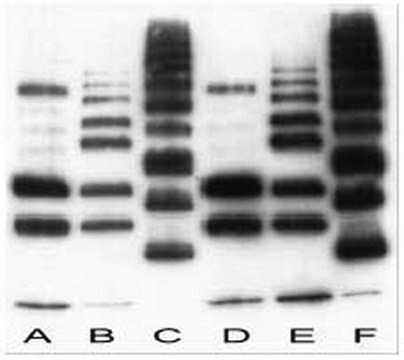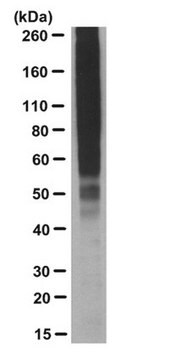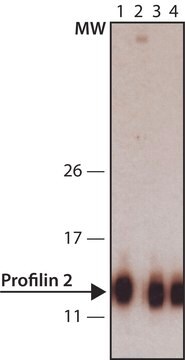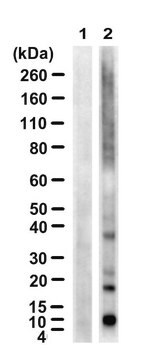05-1307
Anti-Ubiquitin Antibody, Lys48-Specific, clone Apu2, rabbit monoclonal
clone Apu2, from rabbit
Synonim(y):
Anti-HEL-S-50
About This Item
Polecane produkty
pochodzenie biologiczne
rabbit
forma przeciwciała
purified antibody
rodzaj przeciwciała
primary antibodies
klon
Apu2, monoclonal
reaktywność gatunkowa
rabbit, mouse, human, rat
metody
cell based assay: suitable
flow cytometry: suitable
immunocytochemistry: suitable
immunohistochemistry: suitable
immunoprecipitation (IP): suitable
western blot: suitable
izotyp
IgG
numer dostępu UniProt
Warunki transportu
wet ice
docelowa modyfikacja potranslacyjna
unmodified
informacje o genach
human ... UBAP2(55833)
Opis ogólny
Di-Ubiquitin (Lys48-linked) Recombinant Protein (17-10408)
In contrast, polyubiquitin chains linked through the Lys63 residue of ubiquitin (Ub) are associated with nonproteolytic functions such as signal transduction. Lys63-linked polyUb chains connect components of NFκB signaling in a highly regulated manner, and genetic evidence indicates the involvement of Lys63-linked Ub chains in stress response and DNA repair. Research in yeast has suggested Lys63-linked Ub chains stimulate endocytosis.
Specyficzność
Immunogen
Zastosowanie
Ubiquitin (Lys 48-specific) staining of rat brain sections (left figure) or human breast carcinoma (right figure). Staining pattern detects axons of neurons in brain tissue but not surrounding glial cells, and breast tumor cell cytoplasm is strongly detected without nuclear involvement.
Immunocytochemistry:
Confocal IF analysis of NIH/3T3, HeLa, and A431 cells using anti-Ubiquitin (Lys48 specific) (Red). Actin filaments were labeled with AlexaFluor 488-Phalloidin (Green). Nuclear material is stained with DAPI (Blue).
Flow cytometry:
Flow cytometry analysis of Jurkat cells using Anti-ubiquitin Lys48-specific (#05-1307) (blue) and rabbit IgG control (red).
Immunoprecipitation:
Rabbit monoclonal anti-ubiquitin (Lys-48-specific), clone Apu2, precipitated ubiquitin-containing proteins from HeLa cell lysates.
Inhibition Assay:
Preincubation of anti-ubiquitin, Lys48-specific, with K48-multiubiquitin chains inhibited binding to HeLa cell lysate in Western blots.
Signaling
Ubiquitin & Ubiquitin Metabolism
Jakość
A 1:1000-1:5000 dilution of this lot detected Lys-48 ubiquitin chains by Western blotting.
Opis wartości docelowych
Postać fizyczna
Przechowywanie i stabilność
For maximum recovery of product, centrifuge the vial prior to removing the cap.
Komentarz do analizy
Lys48 polyubiquitin chains.
Oświadczenie o zrzeczeniu się odpowiedzialności
Nie możesz znaleźć właściwego produktu?
Wypróbuj nasz Narzędzie selektora produktów.
polecane
Kod klasy składowania
12 - Non Combustible Liquids
Klasa zagrożenia wodnego (WGK)
WGK 1
Temperatura zapłonu (°F)
Not applicable
Temperatura zapłonu (°C)
Not applicable
Certyfikaty analizy (CoA)
Poszukaj Certyfikaty analizy (CoA), wpisując numer partii/serii produktów. Numery serii i partii można znaleźć na etykiecie produktu po słowach „seria” lub „partia”.
Masz już ten produkt?
Dokumenty związane z niedawno zakupionymi produktami zostały zamieszczone w Bibliotece dokumentów.
Klienci oglądali również te produkty
Nasz zespół naukowców ma doświadczenie we wszystkich obszarach badań, w tym w naukach przyrodniczych, materiałoznawstwie, syntezie chemicznej, chromatografii, analityce i wielu innych dziedzinach.
Skontaktuj się z zespołem ds. pomocy technicznej









